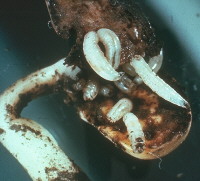Seedcorn Maggot in Kentucky Soybean
ENTFACT-133: Seedcorn Maggot in Kentucky Soybean | Download PDF
Delia platura (Diptera: Anthomyiidae)
by Doug Johnson, Extension Entomologist
University of Kentucky College of Agriculture
The seedcorn maggot (SCM) is widely distributed in the corn/soybean growing regions of the world and has been reported in the United States since at least 1855. SCM has a very wide host range, commonly feeding on seeds of beans, peas, and corn, as well as roots of cabbage, radish and onion sets. In fact, many seeds and roots are at risk if this insect is present.

The larvae (maggots) develop in the soil and feed on decaying organic matter. They also will attack newly planted seeds both before and after emergence. If feeding occurs before germination the seeds will die. This causes reduced plant populations in the form of ‘skips' in the field. If feeding occurs after germination, the resulting damage will vary depending upon the number of maggots present and plant age.
Minor feeding damage may simply slow plant development. Moderate feeding damage to the growing point may result in two stems. Severe damage often kills the plants. Infestations are most often found when full season soybeans are planted cool, wet soil using reduced tillage. The greater the crop residue, the higher the potential for infestation.
The adult stage of the SCM is a small grey fly about 3/8 inches long with black legs. It looks very much like a small house fly. The SCM (larva) is a slender, yellowish-white worm (maggot). It is legless, about 5/8 inches long and tapers over the length of the body to a pointed head. Seed corn maggots over winter as pupae. They emerge in the spring and are commonly seen on flowering heads of grasses. After mating, females lay their eggs singly or in small clusters beneath the soil surface. Each will deposit about 270 eggs over a six week period. Eggs hatch in a week to ten days and the larva will take 7 - 21 days to develop, depending upon temperature. There are several generations each year but SCM are only a pest during the early soybean planting season.
The best method of control for seed corn maggot is to delay planting soybeans until soil conditions favor rapid seed germination. If this is not possible use an insecticide seed treatment (See ENT-13) when planting into cool, wet soil. It is not necessary to use a soil applied insecticide.
For immediate access to more information visit our family of web sites at:
- http://www.uky.edu/Agriculture/IPM/ipm.htm
- http://www.uky.edu/Agriculture/PAT/
- http://www.uky.edu/Agriculture/Entomology/enthp.htm
Other Sources of Kentucky Information on this Insect
- IPM-3 Kentucky Integrated Crop Management Manual for Soybeans
- ENT-13 Insecticide Recommendations for Soybeans
Additional Print References
- Davidson, R. H.,; Lyon, W. F. Insect Pests of Farm, Garden, and Orchard. New York: John Wiley & Sons; 1979.
- Higley, L. G.; Boethel, D. J., editors. Handbook of Soybean Insect Pests. Lanham, MD: Entomological Society of America; 1994.
- Metcalf, R. L.; Metcalf, R. A. Destructive and Useful Insects. New York: McGraw-Hill, Inc. 1993.
- Pedigo, L. P. Entomology and Pest Management. New York: Macmillan Publishing Co.; 1989.
Issued: 4/00
Revised: 4/00
CAUTION! Pesticide recommendations in this publication are registered for use in Kentucky, USA ONLY! The use of some products may not be legal in your state or country. Please check with your local county agent or regulatory official before using any pesticide mentioned in this publication.
Of course, ALWAYS READ AND FOLLOW LABEL DIRECTIONS FOR SAFE USE OF ANY PESTICIDE!
Photo: University of Kentucky IPM Slide Set
